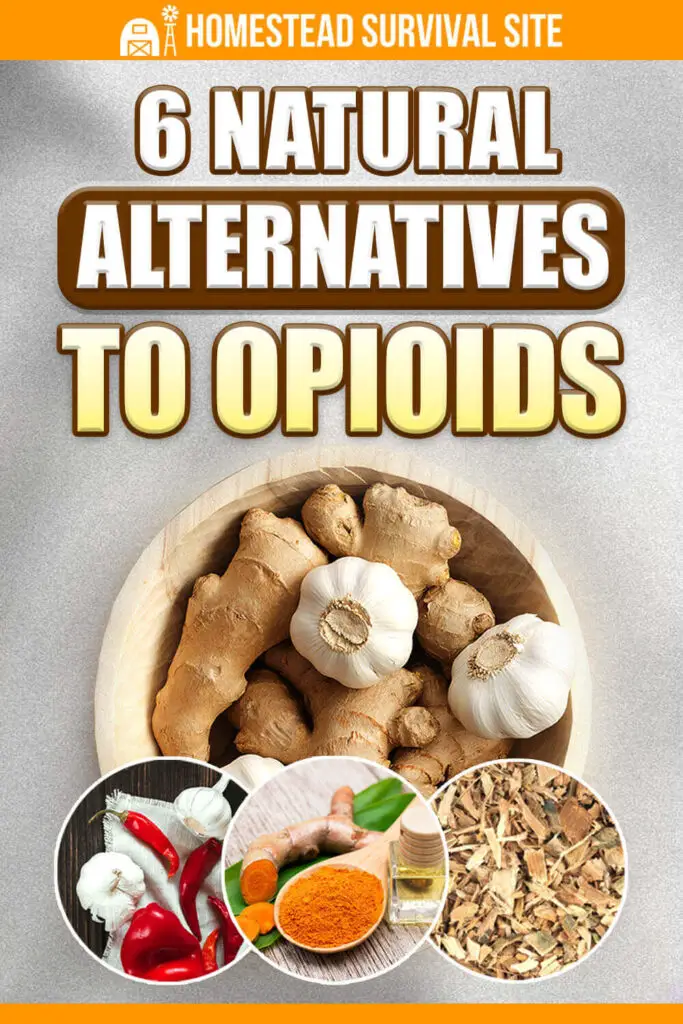Estimated reading time: 6 minutes
Disclaimer: I am not a medical doctor and nothing in this article should be taken as medical advice. Please talk to your doctor before using any of the herbs and/or remedies mentioned in this article.
Drug overdoses are the current leading cause of injury deaths in the United States, and most of these overdoses involve opioids.
Experts estimate that up to 130 Americans die each day in the U.S. due to an opioid-related overdose. Even without an overdose or death, opioid addiction is destroying many individuals’ and families’ lives.
Yet, despite this public health emergency – which worsened during the pandemic – many doctors still routinely prescribe these highly addictive painkillers to their patients.
If you or someone you love is looking for a safer alternative to these medications, this article will provide an overview of some natural options to consider for pain relief.
This article does not represent medical advice. You’ll need to conduct your own research and then discuss what will work best for your situation with your doctor. Be sure to tell your doctor about any other medications you are taking since some of these natural alternatives may cause interactions.
Want to save this post for later? Click Here to Pin It On Pinterest!
What Are Opioids?
Opioids are a class of drugs that work in the brain to block pain signals to the body.
The term “opiates” refers to natural opioids derived from the opium poppy plant, and the broader term “opioids” refers to both natural and synthetic forms of the drugs.
The most commonly prescribed opioids include codeine, morphine, oxycodone (OxyContin), and hydrocodone (Vicodin).
Fentanyl is a synthetic opioid that is similar to morphine but is up to 100 times more potent. The illegal drug heroin is a semi-synthetic opioid made from morphine that has been chemically processed.
Common over-the-counter alternatives to opioids as pain relievers include aspirin, ibuprofen, and acetaminophen. Some people manage their pain with these medications along with other non-drug remedies such as acupuncture, physical therapy, yoga, or massage.
However, there are some other natural options to consider. Many of the following options have been used for centuries for pain relief. Here are seven natural alternatives to opioids for pain relief.
What Are Some Natural Alternatives To Opioids?
1. Cloves
Clove oil contains eugenol, a natural anesthetic that has anti-inflammatory properties. It can be used to reduce pain and swelling after teeth extraction pain and for muscle and joint pain. It has an unpleasant taste, and you should avoid swallowing the oil. Here are a few ways of treating pain with cloves or clove oil.
- Place a cotton ball dampened with clove oil against the affected tooth area for 10 to 20 minutes.
- Place a pinch of powdered clove in the area.
- Chew a whole clove near the affected area.
- Swish clove oil mixed with a carrier oil (such as olive oil or coconut oil) in your mouth, focusing on the painful area. Spit the oil out.
2. White Willow Bark
Often called “nature’s aspirin,” white willow bark contains salicylic acid, a pain-relieving and inflammation-reducing compound. It can help treat joint and muscle pain, back pain, headaches, and menstrual pain. The topical form can also help soothe pain and swelling from insect bites.
You can chew the bark or grind it into a powder to make a tea. Be aware that, like aspirin, willow bark can cause stomach upset, and children under age six should not take it due to the risk of it causing Reye’s syndrome.
This video shows how to harvest and make willow bark tea.
3. Cayenne and Chili Peppers
These potent peppers contain the chemical called capsaicin, which can be effective in reducing the pain of osteoarthritis and other muscle and joint pain.
Here is a recipe for a topical cayenne pepper gel for pain relief:
Slightly heat a half-cup of coconut oil and stir in two tablespoons of powdered cayenne pepper. Allow the gel to cool and then apply it to the affected area up to three times per day.
This video shares more detail on a cayenne pepper salve.
And here is a brief overview of chili pepper extract for pain relief.
4. Ginger and Turmeric
Another dynamic duo to treat pain and inflammation is turmeric and ginger. Both are rhizomes (root stalks) that contain curcumin, which has anti-inflammatory effects on the body.
A soothing cup of ginger-turmeric tea can help relieve pain relief and soothe stomach upset and nausea. Check out this recipe. And here is how to make a ginger compress to treat sore muscles.
You can find more turmeric and ginger pain relief recipes here.
5. Magnesium
Naturally found in the body, especially in the bones and teeth, magnesium helps regulate our nerve function, antioxidant levels, and blood pressure. A deficiency of the mineral can lead to inflammation, muscle weakness, a higher risk of bone fractures, and some forms of chronic disease.
Factors that can put you at risk for magnesium deficiency include consuming too much caffeine or alcohol and a diet high in fat and sugar. Consuming the following foods can help boost your magnesium levels:
- Bananas
- Leafy green vegetables
- Almonds and cashews
- Sesame, pumpkin, and sunflower seeds
- Black beans
- Flax and flaxseed
- Oatmeal
- Brown rice
A relaxing way to absorb magnesium is to take a bath with Epsom salt in the water. Epsom salt, which contains magnesium, may help the body rid itself of toxins that cause inflammation, thereby reducing pain, swelling, and stiffness.
This video shows how to make a homemade magnesium cream as a topical means of pain relief.
6. Boswellia
Boswellia (also known as Indian frankincense) is an herbal extract made from the bark of the Boswellia tree. It is used in traditional Indian (Ayurvedic) medicine. You can take Boswellia orally or use it as an oil to ease pain and inflammation. This video explains how Boswellia works to treat achy joints and arthritis.
Other natural pain killers that have been used for centuries:
- Apple cider vinegar for heartburn or acidity
- Cherries for joint pain
- Peppermint oil for sore muscles
- Stinging nettle for painful joints and inflammation
- Calendula for skin pain, muscle pain, arthritis, and inflammation
Finally, staying hydrated is an essential part of pain management. Since water is the primary component of the blood, dehydration can reduce the body’s blood volume. A lower blood volume means reduced oxygen flow and nutrients moving throughout the body.
Resources for more information
For more on alternative pain medications, here are some additional resources:
- Ancient Remedies
- Better Living Through Neurochemistry
- Essential Oils: Ancient Medicine
- Nature's Pain Killers
- The Pain Relief Secret
Like this post? Don't Forget to Pin It On Pinterest!












